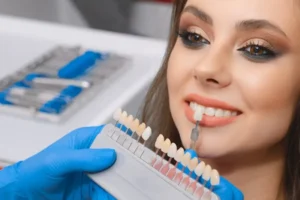Dental veneers are a popular option for individuals looking to improve their smile aesthetics. These thin, custom-made shells are designed to cover the front surface of teeth, altering their color, shape, size, or length. Typically crafted from porcelain or resin composite materials, veneers offer durability and stain resistance comparable to natural tooth enamel. By opting for dental veneers, patients can achieve a natural-looking smile with minimally invasive procedures, making them a favored choice for cosmetic dental enhancements.
What Are Dental Veneers?
Definition and Overview
Dental veneers are a popular cosmetic dental solution used to enhance the appearance of teeth. They are thin, custom-made shells crafted from porcelain or composite resin that cover the front surface of the teeth. Veneers are designed to improve the color, shape, size, and overall appearance of your teeth, providing a natural and aesthetically pleasing look.
The application of dental veneers is a minimally invasive procedure that typically requires only a few visits to the dentist. The process starts with an initial consultation, during which the dentist will assess your dental needs and create a personalized treatment plan. The next steps involve preparing the teeth, taking impressions, and finally, bonding the veneers to the teeth.  This efficient method makes veneers a highly sought-after solution for individuals seeking to improve their smile.
This efficient method makes veneers a highly sought-after solution for individuals seeking to improve their smile.
Types of Dental Veneers
There are mainly two types of dental veneers: porcelain veneers and composite resin veneers. Each type has its advantages and specific applications:
- Porcelain Veneers: These are made from high-quality ceramic and are known for their durability and resistance to stains. Porcelain veneers can last between 10 to 15 years with proper care and maintenance. They also provide a more natural appearance, closely mimicking the light-reflecting properties of natural teeth.
- Composite Resin Veneers: These are crafted from a tooth-colored resin material and are generally less expensive than porcelain veneers. Composite veneers require less enamel removal during the preparation process and can be applied in a single visit. However, they are less durable and may need to be replaced more frequently.
Choosing the right type of veneer depends on various factors, including your budget, dental condition, and aesthetic preferences. Consultation with a qualified dentist is essential to making an informed decision.
Comparison with Other Dental Solutions
When considering dental veneers, it’s important to understand how they compare to other dental solutions like crowns, bonding, and orthodontics. Each option has its specific uses and benefits:
- Crowns: Unlike veneers that only cover the front surface of the tooth, crowns encase the entire tooth. Crowns are often used for more severe cases of tooth decay or damage. While both crowns and veneers can improve the appearance of teeth, crowns offer more comprehensive protection and durability.
- Bonding: Dental bonding involves applying a tooth-colored resin directly to the tooth’s surface and then sculpting it into the desired shape. While bonding is a quicker and more affordable option, it is less durable and may not provide the same level of aesthetic enhancement as veneers.
- Orthodontics: While veneers can address minor misalignments and gaps, orthodontic treatments like braces or clear aligners are more effective for significant alignment issues. Orthodontics focuses on correcting the underlying structure of the teeth and jaw, whereas veneers are primarily cosmetic.
In summary, dental veneers offer a versatile and effective solution for enhancing your smile. By weighing the pros and cons of each option and consulting with a professional, you can determine the best treatment for your specific needs.
If you found this article helpful, be sure to check out our other articles on dental solutions to make well-informed decisions about your oral health.
The Procedure of Getting Dental Veneers
Dental veneers are a popular cosmetic dentistry option for achieving a perfectly aligned and radiant smile. The process involves several critical steps to ensure the best possible outcome. Understanding the procedure can help set your expectations and prepare you for the journey ahead. In general, the process can be broken down into three main phases: the initial consultation, preparation and impressions, and the actual placement and final adjustments of the veneers.
Each of these steps is meticulously planned and executed to deliver natural-looking and long-lasting results. Here is a detailed breakdown of what you can expect during each phase of getting dental veneers.
Embarking on the veneer journey can transform your smile dramatically. Knowing what to expect can make the process smoother and more satisfying.
Initial Consultation
The first step in getting dental veneers is an initial consultation with your dentist. During this visit, the dentist will thoroughly evaluate your oral health to determine if you are a suitable candidate for veneers. This evaluation often includes X-rays and possibly taking impressions of your teeth. The goal is to ensure that your teeth and gums are healthy enough for the procedure. The dentist will discuss your aesthetic goals and expectations and may show you before-and-after photos of previous patients. This is an excellent opportunity to ask any questions you may have about the veneer process. Clear communication with your dentist is crucial to ensure your goals align with the achievable results.
Based on this consultation, your dentist will develop a customized treatment plan tailored to your needs. This plan will outline the number of veneers needed, the shade, and the shape that will best complement your smile.
Preparation and Impressions
Once the treatment plan is finalized, the next step involves preparing your teeth for the veneers. This usually requires removing a small amount of enamel from the front surface of your teeth to ensure a snug fit. The amount of enamel removed is typically around 0.5 millimeters, which is roughly the thickness of the veneer itself. This step is essential for making sure the veneers look natural and do not appear bulky.
After the enamel is removed, your dentist will take impressions of your teeth. These impressions are sent to a dental laboratory where your custom veneers will be fabricated. While your permanent veneers are being made, which usually takes a couple of weeks, you may be given temporary veneers to protect your prepared teeth. It is essential to follow your dentist’s instructions during this period to maintain good oral hygiene and avoid damaging the temporary veneers.
- Keep up with regular brushing and flossing.
- Avoid hard or sticky foods that could dislodge the temporary veneers.
- Attend any follow-up appointments as scheduled.
Placement and Final Adjustments
The final step is placing and adjusting the permanent veneers. This process starts with your dentist checking the fit and color of the veneers. Minor adjustments are often made to ensure the veneers fit perfectly and look natural. Your dentist will then clean your teeth thoroughly before attaching the veneers.
A special cement is used to bond the veneers to your teeth permanently. A curing light is then used to harden the cement quickly, securing the veneers in place. Once the veneers are bonded, your dentist will make any final adjustments to ensure an optimal bite and appearance.
You may be asked to return for a follow-up visit to ensure that the veneers are settling well and that your mouth is responding positively to the new additions. This follow-up is crucial for addressing any concerns and making minor adjustments if necessary.
With proper care, dental veneers can last many years, providing you with a beautiful, lasting smile. Be sure to maintain regular dental check-ups and practice good oral hygiene to keep your veneers looking their best.
Ready to enhance your smile further? Explore our other articles for more dental tips and insights!
Benefits of Dental Veneers
Dental veneers offer a range of advantages that can significantly enhance both the function and appearance of your teeth. These thin, custom-made shells are designed to cover the front surface of your teeth, providing a natural and attractive look. Let’s explore some of the key benefits of dental veneers:
One of the primary reasons individuals opt for dental veneers is their ability to transform a smile swiftly and effectively. With proper care, these veneers can last for many years, making them a long-term solution for a variety of dental issues. Additionally, they are highly stain-resistant, which helps maintain a bright and beautiful smile.
Aesthetic Improvements
When it comes to aesthetic improvements, dental veneers are a top choice. They can correct a multitude of cosmetic dental problems, including:
- Discoloration: Veneers can cover both intrinsic and extrinsic stains, giving you a whiter, brighter smile.
- Chipped or broken teeth: They can restore the appearance of teeth that are chipped or broken, making them look whole again.
- Misalignments: If you have minor misalignments, veneers can help create the appearance of a straighter smile without the need for braces.
- Gaps: Veneers can close small gaps between teeth, enhancing the overall symmetry of your smile.
The materials used in veneers, such as porcelain, mimic the light-reflecting properties of natural teeth, making them virtually indistinguishable from your real teeth. This ensures that your smile looks natural and attractive.
Boost in Self-Confidence
Another significant benefit of dental veneers is the boost in self-confidence they can provide. Many people feel self-conscious about their teeth, which can affect their willingness to smile, speak, or even eat in public. Veneers can help change that.
When you have a smile you’re proud of, it can positively impact your social and professional interactions. A beautiful smile can make you feel more approachable and confident, whether you’re meeting new people or speaking in front of an audience.
Moreover, the process of getting veneers is relatively quick, often requiring just a few visits to the dentist. The immediate transformation can lead to a rapid improvement in self-esteem and overall happiness.
In summary, dental veneers offer both aesthetic and psychological benefits, making them an excellent option for anyone looking to enhance their smile. For more information on dental health and treatments, be sure to check out our other articles!
Common Questions About Dental Veneers
If you’re considering ways to improve the appearance of your smile, you might have heard about dental veneers as a modern solution. Here are some common questions and answers to help you understand what to expect from this cosmetic dental procedure.
What are dental veneers?
Dental veneers are thin covers made typically from porcelain or composite resin that are adhered to the front of your teeth. They are custom-made to fit the shape and color of your teeth, providing a natural-looking solution to conceal gaps, chips, stains, or misshapen teeth. Veneers are durable, but also require precise dental expertise to install and maintain.
How long do dental veneers last?
On average, dental veneers can last between 10 to 15 years, depending on the material used and how well they are taken care of. Porcelain veneers generally last longer than composite resin ones. To maximize their lifespan, it’s important to maintain good oral hygiene, avoid biting down on very hard objects, and visit your dentist regularly for check-ups and maintenance.

My name is Salman Kapa, a 73-year-old expert in bone regeneration and dental implantology. With decades of experience in the field, I am dedicated to advancing our understanding of oral health and hygiene. Through my research and writing, I aim to contribute to the development of innovative solutions in dental care.




